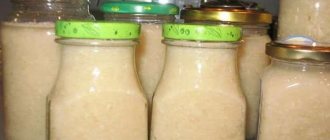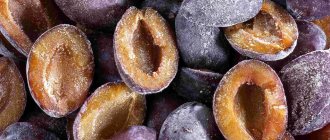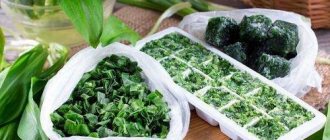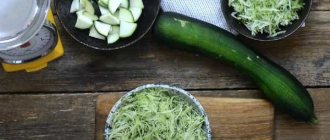When comparing the taste of gooseberries with other berries - strawberries, raspberries, cherries, they most likely lose. But it doesn’t have many competitors in terms of vitamin content. For a long time, the most popular methods of preparing berries for the winter were canning - preserves, compotes, jams. Today, many people try to freeze gooseberries for the winter in the freezer of the refrigerator to preserve all the valuable substances, beneficial properties and taste.
The method is simple, affordable, and does not require a lot of time or additional budget investments. There are several options. You should know how and in what form you can freeze berries so that the resulting preparations for the winter are tasty, healthy and in demand.
Is it possible to freeze gooseberries?
Thanks to the functionality of modern freezers and refrigerators, it has become possible to freeze almost any vegetables, fruits, and herbs, while obtaining high-quality products. With the same success, gooseberries can be frozen for the winter. The main advantage of such products is their high quality, preservation of all properties after defrosting.
Among the main methods of freezing:
- in bulk;
- with sugar;
- in syrup;
- like puree;
- assorted with other ingredients.
When preparing berries, freezing them and further using them, it is necessary to observe the basic rules of packaging, storage, and temperature control.
Freezing is the best storage method
For a long time, one of the most popular ways of preparing food for the winter was canning - preparing compotes, jams, preserves. With the advent of modern freezers, housewives can keep food fresh for a long time.
Properly frozen berries lose only about 10% of their vitamin and mineral reserves
The benefits of frozen gooseberries
When you freeze gooseberries for the winter at home, the bulk of the beneficial substances contained in them are preserved. The loss of vitamins from such processing does not exceed 10%, so thawed berries are a real storehouse of substances beneficial to the body. They include:
- vitamins B, PP, A, E;
- iodine;
- molybdenum;
- potassium;
- calcium;
- iron;
- zinc;
- fluorine;
- magnesium;
- alimentary fiber;
- organic acids.
Thanks to this chemical composition, gooseberries, even after freezing, have a lot of healing properties:
- stimulates metabolic processes in the body;
- helps strengthen blood vessels and improve blood circulation;
- has a choleretic and diuretic effect;
- removes salts of heavy metals;
- strengthens the nervous system;
- increases immunity;
- prevents strokes and heart attacks;
- successfully fights anemia in pregnant women;
- eliminates constipation.
Both ripe and unripe gooseberries that have been frozen have these properties, provided the berries are stored correctly.
Reviews
Marina, Moscow Previously, I didn’t know what to do with gooseberries - no one eats jam. Recently I started freezing it, like other berries. It is ideal for freezing because it is dense. In winter, I cook compotes from it along with other berries and make jelly.
Anna, Tula I don’t know whether it’s possible to freeze gooseberries for the winter or not, but I decided to freeze them whole. At first I didn’t know what to do with this preparation, but one day I came across a recipe for sauce for meat and now I cook it all the time. My sour gooseberries are perfect for this recipe.
Zhenya, St. Petersburg We don’t really like gooseberries. So that the goodness does not go to waste, I freeze it and throughout the winter I gradually add other berries and fruits to compotes. Recently a new recipe for compote made from gooseberries, lime or lemon wedges and a sprig of mint has appeared. I even make this refreshing drink for guests – it turns out quite tasty.
How to freeze gooseberries for the winter in the refrigerator
To get a healthy product, you need to prepare whole, ripe berries without signs of disease. Collection is carried out in dry, warm weather in the morning. The best varieties are those with thick skin and sweet flesh. Thin-skinned - used for freezing in syrup or making purees.
The berries are sorted, removing leaves and twigs and cutting off the tails.
The gooseberries are washed under cold running water in a sieve or colander and laid out on a towel to dry. If the moisture remains, then after placing it in the refrigerator the berry turns into a single ice lump.
When harvesting gooseberries for the winter, freezing is carried out at a temperature of -30 ... -35 ⁰C. Further long-term storage is carried out at a temperature of -18 ... -25 °C in the freezer compartments of refrigerators or in chambers with a large volume and the ability to set lower temperatures.
Attention! When placing berries in boxes and containers, it is worth remembering that after freezing the gooseberries, the cell juice turns into ice, then the volume of the product increases by 10%.
What berries are suitable for freezing?
For freezing, it is better to choose yellow-green berries of certain varieties. Frozen red gooseberries may become soft after defrosting.
It is recommended to pick the fruits when they are not yet fully ripe. Ripeness can be checked by lightly pressing the berry with your fingers: it should be moderately elastic. If you prefer a sweeter berry without pronounced sourness, wait until it is fully ripe. Harvest in sunny, dry weather in the morning.
| On a note. It is not recommended to freeze berries immediately after picking them. Keep them in the refrigerator at negative temperatures for a couple of days, then the berries will harden a little and will not soften after defrosting. |
Whole frozen gooseberries recipe
Whole berries, stored for the winter, are a good basis for preparing many dishes: yoghurts, compotes, fruit drinks, pie fillings, buns, muffins. After defrosting, they do not lose their appearance, and their taste remains high.
According to reviews, freezing whole gooseberries for the winter is the easiest and fastest way. To do this you need:
- Prepare gooseberries, trays or baking sheets, parchment paper and bags in advance.
- Free up space in the freezer.
- Line trays and baking trays with paper.
- Place gooseberries in the prepared container in one layer.
- Place the trays in the freezer to freeze for at least 4 hours.
- Remove the trays from the freezer, lift the parchment and pour the berries into the bags using a wooden spoon so that they do not “stick” to your hands.
- Place notes in the bags about the contents and freezing time.
- Place the bags in the freezer.
Product storage is at least three months.
Selection and preparation of berries
For food consumption, ideally use gooseberries from your own harvest or grown in guaranteed safe conditions without pesticides. When buying beautiful fruits at the market, store or supermarket, you cannot be sure of their quality. When growing them, chemicals are often used to stimulate growth, fertilizers, and protective agents that are toxic to the human body.
Berries for freezing are harvested when they are most ripe and contain the most vitamins and minerals, i.e. in June - August. The ripening period depends on the variety, climatic and weather conditions.
When harvesting or purchasing a product on the market, it is important to evaluate the quality of gooseberries, paying attention to appearance, smell, and taste. Good berries are moderately elastic to the touch and of the same size. If the fruits are too hard, it means they have not reached maturity; if they are soft, they are already overripe. The presence of black spots on the gooseberries is allowed - this is a sign of maturity, characteristic of some varieties. Berries spoiled by pests are not suitable for consumption and long-term storage.
Advice. It is better to harvest early in the morning in sunny weather. The fruits must be dry, otherwise they will quickly spoil.
The next stage is preparing gooseberries for freezing for the winter:
- Rinse the berries until the water is clear, remove leaves, foreign debris, rotten, spoiled, too soft and green fruits.
- Place the gooseberries in a colander and allow excess water to drain. Then transfer to a paper towel or cotton cloth to absorb all the moisture.
This is interesting:
How to properly freeze carrots for the winter in the freezer.
We choose how to cover the onions from frost for the winter and study the nuances of the process.
Gooseberries, frozen for the winter with sugar
This recipe for freezing gooseberries with sugar is often used by housewives. It is not labor intensive. For preparation you will need:
- bags or containers with lids;
- 2 kg of berries;
- 700 g granulated sugar.
To make quality preparations for the winter, you need:
- Collect or buy dense whole berries, rinse them and clear them of debris and tails.
- Dry the gooseberries completely.
- Pour it into a large container and add the prepared sugar.
- Mix the ingredients.
- Fill containers or bags with berries, putting no more than 500 g in each (for one-time use).
- Cover tightly and place in the freezer.
Storage bags must be intact, containers must be clean, free of foreign odors, and lids must fit tightly. Glassware is not suitable for storage in the freezer as it may break due to the cold.
Advice! It is worth labeling the containers with the contents, indicating what is in them and when the product expires.
Harvesting whole berries
Frozen gooseberries can be stored without sugar. It needs to be washed, dried and laid out in 1 layer on a tray covered with parchment. The product must be placed in the freezer for several hours. Then it must be packaged in small quantities.
If the fruit has a dense shell, after drying it can be placed in large bags. By choosing convenient storage containers, you can save space in your camera. Berries in flat containers freeze quickly and lose almost no benefit.
Freezing gooseberries in the form of puree for the winter
Overripe gooseberries have thin skin and may burst. It is better to use such berries for making purees and then freezing them. For this purpose, washed and peeled berries are thoroughly crushed. Experts advise using ordinary wooden masher, since gooseberry fruits lose most of their vitamins when they come into contact with the metal parts of a blender or meat grinder.
Sugar is added to the resulting puree at the rate of 400 g per kilogram of gooseberries. If the berries are very sour, then its amount can be increased. The puree is thoroughly mixed, placed in small portions into containers and cooled in the refrigerator. After cooling, the containers are tightly closed and placed in the freezer.
In the recipe for freezing gooseberries for the winter in the form of puree, you do not need to include sugar. In this case, the calorie content of the product will be significantly lower, and its beneficial properties will be no less.
FAQ
What to cook from frozen gooseberries? From frozen berries you can make compotes, fruit drinks, jelly, smoothies, yoghurts, jellies, popsicles, hot sauces for meat, jam, filling for pies and other baked goods.
You can quickly and easily make a delicate smoothie from frozen gooseberries. In addition to berries, you will need a banana, which will soften the taste, seeds, poppy seeds or nuts, milk or juice. Place the gooseberries in a blender bowl, add the banana cut into pieces, pour in milk or juice. Beat with a blender until smooth and fluffy. For taste, add seeds, poppy seeds or nuts. You can also add a spoon of honey.
A delicious and healthy gooseberry and banana smoothie can be prepared in just five minutes.
How long to store? At a temperature of about -20 degrees, gooseberries, frozen whole without sugar, can be stored for up to one year. If the temperature is not lower than –8 degrees, the berries will last no more than 3 months without loss of quality. Fruits prepared as puree in closed plastic containers can be stored for up to 6 months.
Recipe for freezing gooseberries in sugar syrup for the winter
The freezing option in sugar syrup, like the previous one, is suitable for overripe berries or varieties with soft skin. Such freezing can be used not only for preparing dishes, but also as a separate, ready-made dessert.
You will need:
- gooseberries;
- sugar (0.5 kg);
- water (1 l).
To prepare the workpiece, you must perform a number of sequential steps:
- Boil a thick syrup from sugar and water.
- Cool it down.
- Place the prepared berries into containers.
- Pour syrup over gooseberries.
- Place containers in the freezer.
- Do not cover with lids for two days.
- To freeze.
- Close the lids tightly.
Temperature
For berry mixtures from the supermarket, blast freezing is used - a gradual decrease in temperature. This allows you to preserve the rich color of the fruit, natural taste and aroma. In everyday life you need to adhere to other rules:
- For storage of 12 months, a temperature of -18 degrees or lower is required. Household cameras usually do not go below -30 degrees.
- If freezing occurred from 0 to -8 degrees, then the product should be stored for no more than 3 months.
- New refrigerators and freezers feature “deep freezing”, which works on the principles of shock technology.
How to freeze gooseberries along with other berries
For children, a real treat can be berry puree, which housewives include gooseberries, red and black currants, sea buckthorn, and strawberries. Small and large, soft and hard fruits are suitable. After grinding them, add 5 tablespoons of sugar per 500 g of mass and mix. Add whole gooseberries or chopped strawberries to the finished puree. The mixture is infused for an hour, after which it is poured into silicone molds and placed in the freezer. Once the puree has hardened, it is removed from the molds, placed in bags and stored in the freezer.
After heating, frozen can be used as a ready-made dessert for children or as a base for sauces for pancakes and cheesecakes.
Important! The amount of added sugar is reduced or increased based on taste preferences and the sweetness of the berries included in the puree.
What can you cook from frozen gooseberries?
Experienced housewives, leaving their reviews of frozen gooseberries, note that they are an excellent preparation for many dishes.
One of the simplest solutions is to prepare a smoothie, for which, in addition to gooseberries, you will need a banana - for thickness, nuts, seeds or bran - to give a richer taste, as well as juice or milk.
A spicy seasoning for meat or fish can be obtained from harvesting gooseberries, dill, and garlic.
Frozen berries serve as a filling with a bright taste for yeast pies, shortbread pies, and muffins.
Most often, frozen berries are used to make jellies, compotes, and jelly.
The easiest way is to defrost the healthy product and eat it in the form in which it was prepared for freezing.
Composition and calorie content of gooseberries
Gooseberries are a storehouse of vitamins and microelements. Dark-colored fruits contain vitamins C, P, and A in abundance. They contain folic acid and other valuable B vitamins.
Of the trace elements in gooseberries, there is calcium and potassium, manganese and sodium, iron and iodine, zinc and copper, cobalt and phosphorus.
Pectin, tannins, malic acid, citric acid, serotonin and flavonoids, valuable for the human body, are also present in the fruits of this plant.
100 grams of this tasty and healthy berry contains 44 kcal.
Storage and defrosting rules
To maintain the proper quality of products, you should follow the rules for storing and defrosting them before use:
- freezing of berries should take place quickly, in small portions;
- the optimal temperature for storing food for 10 months is about -20 ⁰C;
- the “deep freezing” function of the freezer is turned on a day before use;
- Frozen gooseberries should not be placed next to meat or fish products so that they do not develop an unpleasant odor;
- You should not fill the boxes and chambers completely, since when frozen, the volume of berries increases by no less than 10% of the original;
- defrosting is carried out gradually, for which the container is transferred to the bottom shelf of the refrigerator;
- after defrosting, the product must be consumed; re-freezing is unacceptable;
- compotes, jelly, can be prepared immediately after the container is removed from the freezer.
Useful tips
A few simple tips from experienced housewives:
- to preserve the delicate aroma of gooseberries, do not place them next to foods that have a strong odor (meat, fish, etc.);
- The deep freezing mode should be turned on in the freezer a day before placing the berries in it, and the normal mode should be set a day after that;
- The shelf life of fruits at temperatures from −18 to –23 ℃ is 8-12 months. If the temperature in the freezer is not lower than −8 ℃, it is reduced to 3 months;
- defrosting must be done gradually, moving the berries from the freezer to the general compartment of the refrigerator;
- When adding to hot dishes, for example, compote or porridge, you can use frozen fruits directly from the container.











